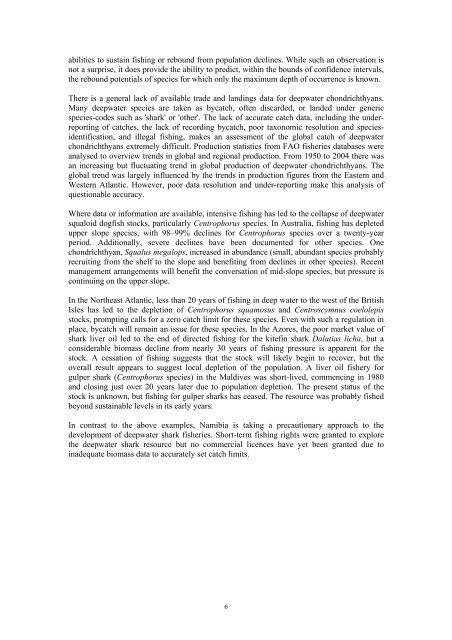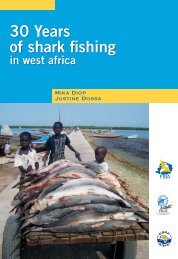Kyne & Simpfendorfer.. - Shark Specialist Group
Kyne & Simpfendorfer.. - Shark Specialist Group
Kyne & Simpfendorfer.. - Shark Specialist Group
You also want an ePaper? Increase the reach of your titles
YUMPU automatically turns print PDFs into web optimized ePapers that Google loves.
abilities to sustain fishing or rebound from population declines. While such an observation is<br />
not a surprise, it does provide the ability to predict, within the bounds of confidence intervals,<br />
the rebound potentials of species for which only the maximum depth of occurrence is known.<br />
There is a general lack of available trade and landings data for deepwater chondrichthyans.<br />
Many deepwater species are taken as bycatch, often discarded, or landed under generic<br />
species-codes such as 'shark' or 'other'. The lack of accurate catch data, including the underreporting<br />
of catches, the lack of recording bycatch, poor taxonomic resolution and speciesidentification,<br />
and illegal fishing, makes an assessment of the global catch of deepwater<br />
chondrichthyans extremely difficult. Production statistics from FAO fisheries databases were<br />
analysed to overview trends in global and regional production. From 1950 to 2004 there was<br />
an increasing but fluctuating trend in global production of deepwater chondrichthyans. The<br />
global trend was largely influenced by the trends in production figures from the Eastern and<br />
Western Atlantic. However, poor data resolution and under-reporting make this analysis of<br />
questionable accuracy.<br />
Where data or information are available, intensive fishing has led to the collapse of deepwater<br />
squaloid dogfish stocks, particularly Centrophorus species. In Australia, fishing has depleted<br />
upper slope species, with 98–99% declines for Centrophorus species over a twenty-year<br />
period. Additionally, severe declines have been documented for other species. One<br />
chondrichthyan, Squalus megalops, increased in abundance (small, abundant species probably<br />
recruiting from the shelf to the slope and benefiting from declines in other species). Recent<br />
management arrangements will benefit the conversation of mid-slope species, but pressure is<br />
continuing on the upper slope.<br />
In the Northeast Atlantic, less than 20 years of fishing in deep water to the west of the British<br />
Isles has led to the depletion of Centrophorus squamosus and Centroscymnus coelolepis<br />
stocks, prompting calls for a zero catch limit for these species. Even with such a regulation in<br />
place, bycatch will remain an issue for these species. In the Azores, the poor market value of<br />
shark liver oil led to the end of directed fishing for the kitefin shark Dalatias licha, but a<br />
considerable biomass decline from nearly 30 years of fishing pressure is apparent for the<br />
stock. A cessation of fishing suggests that the stock will likely begin to recover, but the<br />
overall result appears to suggest local depletion of the population. A liver oil fishery for<br />
gulper shark (Centrophorus species) in the Maldives was short-lived, commencing in 1980<br />
and closing just over 20 years later due to population depletion. The present status of the<br />
stock is unknown, but fishing for gulper sharks has ceased. The resource was probably fished<br />
beyond sustainable levels in its early years.<br />
In contrast to the above examples, Namibia is taking a precautionary approach to the<br />
development of deepwater shark fisheries. Short-term fishing rights were granted to explore<br />
the deepwater shark resource but no commercial licences have yet been granted due to<br />
inadequate biomass data to accurately set catch limits.<br />
6
















